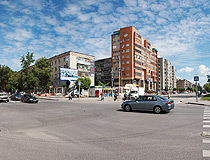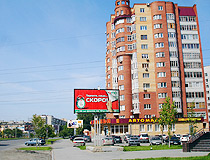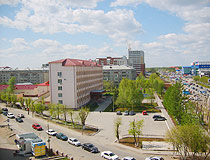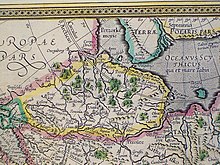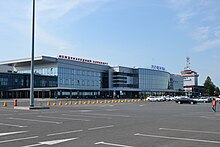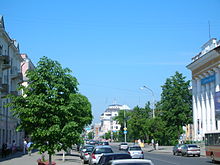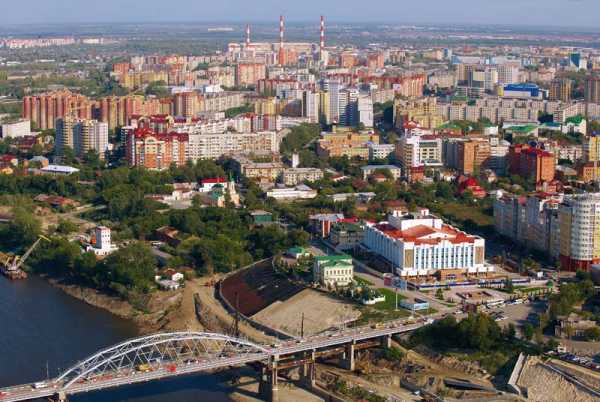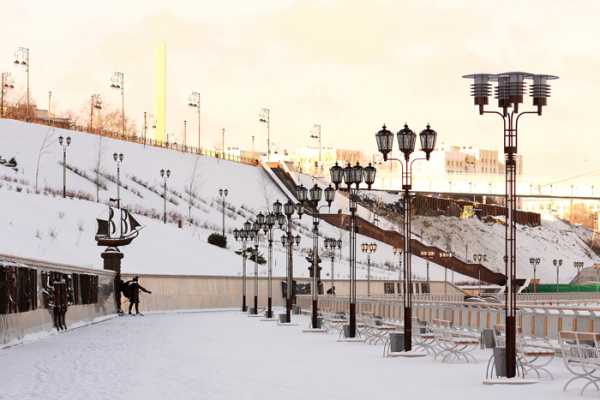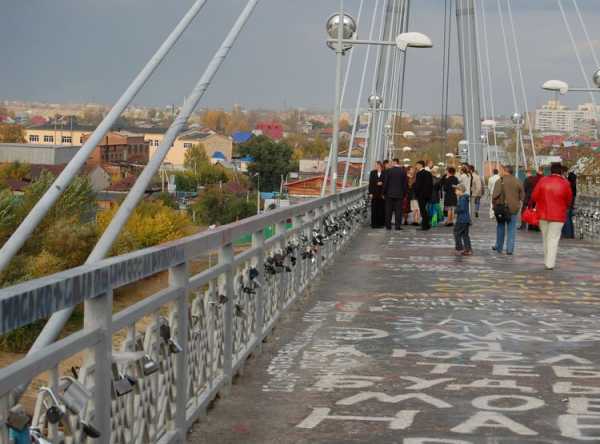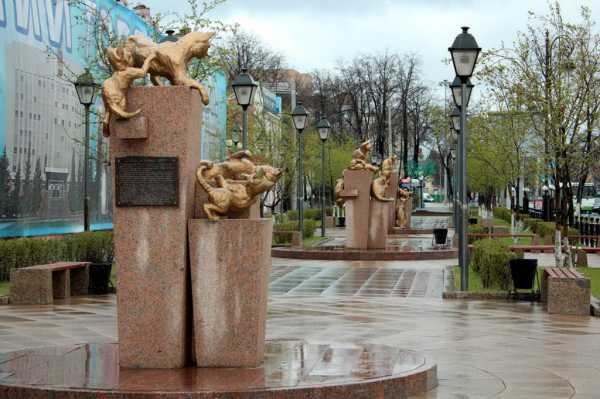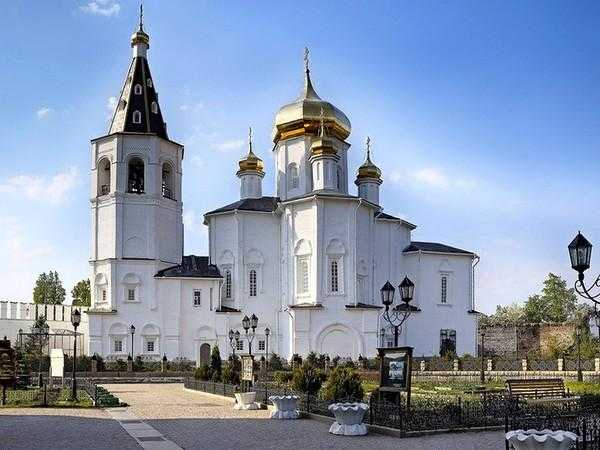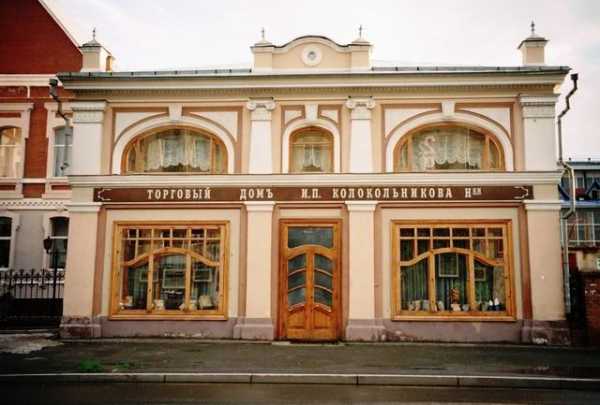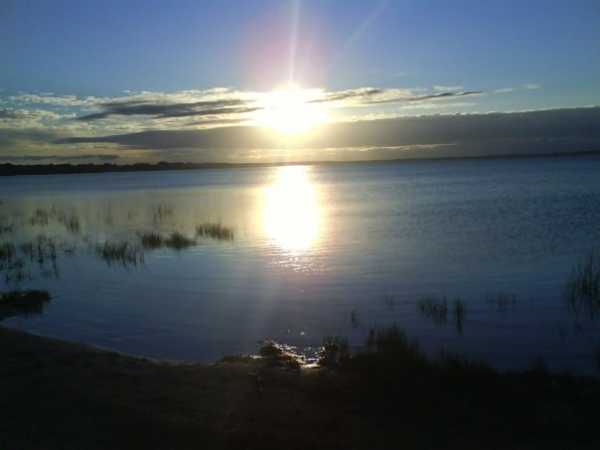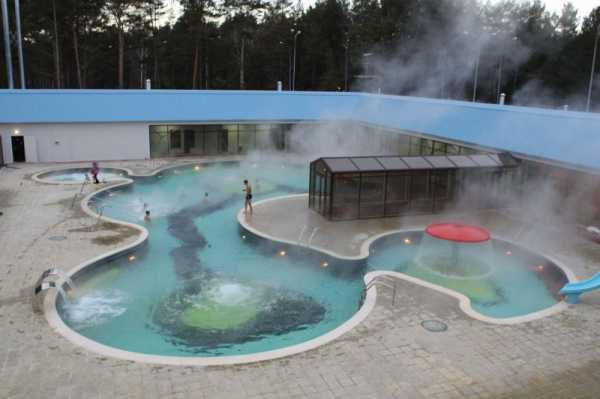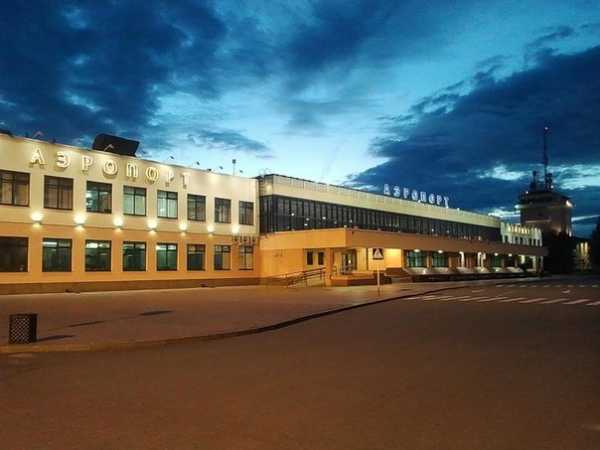Предлагаем Вам прогуляться по Тюмени, нефтегазовой столице нашей страны, и познакомиться с её достопримечательностями.
Перед экскурсией повторите следующие слова:
sights [сайтс] — достопримечательности,
bridge [бридж] — мост,
river [ривэ] – река,
church [чёч] – церковь,
monument [моньюмент] – памятник,
public garden [паблик гадэн] – сквер,
museum [мьюзиэм] – музей.
Тюмень — первый русский город Сибири.
Tyumen is the first Russian city in Siberia.
First или 1st – [фёст] — первый.
В английском языке порядковые числительные образуются путем прибавления суффикса -th к количественным числительным.
Например,
four— четыре,
the fourth – четвертый.
seven – семь,
the seventh – седьмой.Исключением из этого правила являются слова :
первый — the first [фёст],
второй –the second [сэконд],
и третий – the third[сёд].
Первая достопримечательность – пешеходный мост или мост влюбленных.
The first sight is the footbridge or bridge of love.
Это мост через реку Тура.
This bridge is over the Tura river.
Вторая достопримечательность – церковь Михаила Архангела.
The second sight is St. Michael the Archangel’s Church.
Эта церковь является памятником архитектуры федерального значения.
This church is the national architectural monument.
Всего в Тюмени 14 памятников архитектуры и 3 памятника истории.
There are 14 architectural monuments and 3 historic monuments in Tyumen.
Третий пункт в нашей экскурсии — интересный сквер в самом центре города.
The third sight is the interesting public garden in the very center of the city.
Это сквер сибирских кошек.
It’s The Siberian Cats’ Public Garden.
How did the Siberian cats save the main museum of our country?
Как сибирские кошки спасли главный музей нашей страны?
По легенде, тюменцы отправили в Ленинград, переживший блокаду, целый вагон животных — 238 котов и кошек, чтобы спасти город от крыс. Всего из Сибири в Ленинград было отправлено около 5 тысяч питомцев. Так кошки из Сибири спасли один из главных музеев нашей страны — Эрмитаж.
Многие изучающие английский язык используют слово square, чтобы обозначить небольшой городской общественный парк, но это ошибочно. В английском языке square [сквэа] означает квадрат, прямоугольник. Если говорить о городской планировке, square обозначает часть города, имеющую квадратную или прямоугольную форму. Этот квадрат может быть застроенным – квартал или не застроенным — площадь.
He lives in the next square [хи ливз ин зэ некст сквэа] – он живет в соседнем квартале.
Red square [рэд сквэа] – красная площадь.
Русскому слову сквер в английском языке соответствует словосочетание public garden.
Последним пунктом нашей экскурсии становится посещение тюменских музеев.
The last step of our excursion is visiting of the museums of Tyumen.
Для того, чтобы составить представление о культуре и истории этого красивого северного города, советуем Вам посетить следующие музеи:
Fine Arts Museum – Музей изобразительных искусств
Archeology, Antropology and Ethnoghraphics Museum – Музей археологии.
Local Lore Museum – Краеведческий музей
The Kolokolnikovs’ Estate Museum Complex – Усадьба Колокольниковых.
Tyumen is the administrative center of Tyumen Region, which divides Russia into the European and Asian parts. The city is located in the south of Western Siberia, on the banks of the Tura River, 2,200 km away from Moscow.
First City in Siberia
It was Tyumen in 1586 that started Siberia’s integration into Russia. Mikhail Lomonosov once famously said, «Russia’s power will become stronger with Siberia.» A part of this phrase is now written on the coat of arms of Tyumen Oblast.
Though many people think that Tyumen was founded by the Siberia conqueror Yermak, in fact, the founders were Vassily Sukin and Ivan Myasnoy – Russian warlords. They came to Siberia to establish Russian rule after Yermak’s death and built a fortress at the site of the current Tyumen. Earlier, there was a town here called Chingi-Tura, the capital of the Siberian Khanate.
City of Black Gold
Tyumen is the oil and gas capital of Russia. In the 1960s, major oil deposits were discovered here, and development of the Yugra and Yamal lands began. In record time, large enterprises and modern cities appeared in the midst of the empty and marshy spaces of Siberia. Tyumen soon became the administrative center of the region, managing the oil and gas enterprises.
City of Culture
Tyumen has everything to satisfy your cultural needs. Since 1858, the city has had the Drama Theater, the oldest in Russia, and in 2008 a large new building was constructed for it. Recently, the Tyumen Circus was re-launched in the restored building. The residents are rightfully proud of their modern S.I. Mendeleev Library, equipped with the most modern equipment.
City of Science
Oil and gas production in Tyumen Oblast stimulated the opening of many scientific institutes in the city. By the late 80s, the number of scientific workers in Tyumen was approximately 18,000 (roughly 10% of the population). Now, there are scores of R&D institutes in the city and its suburbs.
City of Gastronomy
Tyumen has many restaurants offering the unique Northern cuisine. When asked about the most interesting dining sites, locals often name the Chum restaurant. There you can eat delicious meals and learn the history of the region. Waiters also serve as guides, telling captivating stories about geologists of the 1960s who came to conquer this wild region. Also, the restaurant displays exhibits provided by the Tyumen Local History Museum. The most popular dishes are sliced frozen whitefish and venison salad. Besides, the restaurant was sanctified by a real Siberian shaman, so people believe that if you make a wish there, it will certainly come true.
City for Strolling
The most popular place for strolling is the Tura River embankment and Lovers’ Bridge connecting its banks. One more pedestrian area in the center of the city is Tsvetnoy Boulevard, with several squares with fountains, museums, and the circus. You can visit the Siberian Cat Park, at which monuments to 12 Siberian cats are erected to memorize that they once saved the State Hermitage in St. Petersburg from a rat invasion.
City of Many Religions
Tyumen is populated by adherents of varying religions. The city hosts the Orthodox and Catholic churches, mosques, a synagogue, and other religious facilities. The St. Trinity Monastery built in the early 17th century still operates in the city.
Near the City
In winter, you can leave the city, jump into a sleigh with Siberian huskies harnessed, and drive across the snowy forest. After driving, you can visit the Verkhny Bor Recreation Center and swim in the outdoor pool with therapeutic water supplied from the hot spring Eldorado. You can also visit the birthplace of the famous chemist Dmitry Mendeleyev – Tobolsk, 200 km away from Tyumen. The Tobolsk Kremlin, a unique masterpiece of Siberian architecture, is also located there.
History of Tyumen
Foundation of Tyumen
In the 13th-16th centuries, on the banks of the Tyumenka River, there was the capital of the Tyumen Khanate — Chingi-Tura. The construction of the Russian fortified settlement of Tyumen began near the remains of Chingi-Tura in the summer of 1586, during the conquest of Siberia by the Russians.
In the Russian chronicles of the 16th century, the Tyumen Khanate was called “Great Tyumen”. “Tumen” (“tyumyan”) in Turkic languages means “lower reaches of the river”, “lowland”. The same word also means a military unit 10 thousand people strong.
Tyumen was founded as an outpost for the conquest and development of Siberia and the Far East on the old caravan road from Central Asia to the Volga region. Waterways connected Tyumen with the lands of the Far North and East. The original population of Tyumen, as a frontier town, consisted of boyars (Russian nobility), streltsy (Russian firearm infantry), and Cossacks. In 1616, the Trinity Monastery was founded in Tyumen by the monk Nifont.
In the first years after its foundation, Tyumen was subjected to attacks by Tatars and Kalmyks. Over time, with the disappearance of the military threat, crafts became the primary occupation of the townspeople (blacksmithing, bell-making, soap-making, and tanning).
More Historical Facts…
Tyumen in the 17th-19th centuries
One century after its foundation, about 2 thousand people lived in Tyumen. In 1695, a fire broke out, as a result of which the wooden town burned down. After that, stone construction began in Tyumen. Of the stone structures of that time, the complex of buildings of the Trinity Monastery has been preserved.
At the beginning of the 18th century, Tyumen was a major transit point for trade; trade routes from China and all of Siberia to the center of Russia passed through the town. Tyumen was famous for the production of furniture and other wood products. In 1763, 6,593 people lived here, of whom 317 were artisans.
In the 19th century, simultaneously with the decline of Tobolsk, rapid growth began in Tyumen. In 1836, the first steamer in Siberia was launched in Tyumen. It became one of the largest river shipbuilding bases in the Russian Empire. In 1885, the Yekaterinburg-Tyumen railway was put into operation. At the end of the century, the cargo turnover of the Tyumen port reached 230 thousand tons per year, and the port itself was called “the gateway to Siberia”.
By the beginning of the 20th century, the number of residents of Tyumen reached 30 thousand and exceeded the population of Tobolsk. In Tyumen, there were 117 factories, including 3 shipyards, 2 steam mills, 70 tanneries, and other enterprises. In 1913, the Tyumen-Omsk railway connected the city with the Trans-Siberian Railway.
Tyumen in the 20th century and beyond
From 1923 to 1934, Tyumen was the center of the Tyumen District within Ural Oblast. On January 17, 1934, this huge region was divided into three oblasts — Sverdlovsk Oblast with the center in Sverdlovsk (Yekaterinburg), Chelyabinsk Oblast with the center in Chelyabinsk, and Ob-Irtysh Oblast with the center in Tyumen. From December 7, 1935 to August 14, 1944, Tyumen was part of Omsk Oblast. In 1939, the population of Tyumen was 79,205 people.
During the Second World War, the industrial potential of Tyumen increased significantly due to the enterprises evacuated from the European part of the USSR. In total, 22 evacuated enterprises were operating in the city, producing armored boats, mortars, motorcycles, electrical equipment for tanks, shells, mines, short fur coats, felt boots, and food. About 20 thousand residents of Tyumen fought at the front.
On August 14, 1944, Tyumen Oblast was formed — the largest region in the country in terms of area. The distance from the southernmost point of the region to the northernmost point was 2,100 km, and from west to east — 1,400 km. Tyumen became the administrative center of this new region.
In the 1960s, large deposits of oil and natural gas were discovered in the north of the Tyumen region, which became a new page in the history of Tyumen. In 1966, the construction of the Tyumen — Tobolsk — Surgut — Nizhnevartovsk railway began. A lot of enterprises of the city began to work for the oil and natural gas extraction industry.
Tyumen became the starting point and transshipment point for the delivery of goods to the North. New specialized enterprises, design institutes, and higher educational institutions were opened in the city. From 1959 to 1979, the population of Tyumen doubled — from 150 to 359 thousand people.
Tyumen Oblast became the country’s main oil and natural gas energy base. By the end of the 1980s, about 400 million tons of oil and 574 billion cubic meters of natural gas were annually produced here. In 1989, the population of Tyumen was 476,869 people.
In the 2010s, Tyumen was significantly transformed: new micro-districts, roads, bridges were built, streets were expanded. In 2015, the 700 thousandth inhabitant of the city was born. In 2020, the population of Tyumen exceeded 800 thousand people. In today’s Russia Tyumen is one of the fastest growing cities.
Streets of Tyumen
Apartment house in Tyumen
Author: Nesmachnykh Konstantin
Spring in Tyumen
Author: Shatalov Vladimir
Tyumen — Features
Tyumen is located in the south of Western Siberia, in the Asian part of Russia, on both banks of the Tura, the left tributary of the Tobol River. Tyumen is a large industrial city, the oil and natural gas capital of Russia, as the administrative center of the largest oil and natural gas producing region. The City Day of Tyumen is celebrated on the last Saturday of July.
The climate in Tyumen is transitional from moderately continental to sharply continental. The average temperature in January is minus 15 degrees Celsius, in July — plus 18.8 degrees Celsius. The warm period lasts only 3-4 months here. The longest seasons are autumn and spring. The weather in the city can change quickly, in the morning it is sunny and warm, and in the evening it is snowy and frosty.
Today’s coat of arms of Tyumen is generally very similar to the historical coat of arms approved in 1785. The image of a wooden river boat, according to the historical description, means that “from this town begins sailing along the rivers of all Siberia.”
The Trans-Siberian Railway “Moscow — Vladivostok” passes through Tyumen. At present, it is the only transcontinental railway that completely passes through the territory of Russia. It is adjoined by the Tyumen — Novy Urengoy railway line, which serves the transportation of the northern regions. The main feature of the Tyumen transport hub is that it is the only point of connection to the all-Russian transport network of the main transport communications of the Khanty-Mansiysk Autonomous Okrug — Yugra and the Yamalo-Nenets Autonomous Okrug.
The main air gateway to Tyumen is the international airport “Roshchino” named after D. I. Mendeleev. Located about 13 km west of Tyumen, this airport offers regular flights to such cities as Kaliningrad, Krasnodar, Moscow, Nizhnevartovsk, Novy Urengoy, Perm, Rostov-on-Don, Salekhard, St. Petersburg, Sochi, Surgut, Ufa, Khanty-Mansiysk, and a number of others.
Oil and natural gas of the Tyumen region contributed to the rapid growth of scientific organizations in the city. In total, several dozen research and design institutes are located here. Fundamental science is represented by the Institute of the Earth’s Cryosphere and the Institute for the Problems of the Development of the North. Applied science is focused on the needs of the oil and natural gas industry. Thousands of students study in 15 higher education institutions.
The beautiful wooden architecture of Tyumen should be noted separately. The unique carved decoration of the Tyumen buildings of the second half of the 19th — early 20th centuries uses the traditions of Russian decorative art, folk motives, as well as creatively reworked artistic techniques of the Renaissance, Baroque, Classicism, and partly Art Nouveau. Often, styles are combined, complemented by local motifs, forming a unique look of wooden architecture, characteristic only of Tyumen.
There are 17 federal cultural heritage sites in Tyumen. Among the specially protected natural areas in the city are the Botanical collection of the biological faculty of Tyumen State University (3 hectares), as well as the regional natural monuments Forest Park named after Yu.A. Gagarin (105 hectares) and the Zatyumensky Forest Park (77 hectares). In the vicinity of Tyumen there are about five hot (37-50 degrees Celsius) geothermal springs.
Interesting facts from the history of Tyumen during World War II
During the war, the body of V. I. Lenin was evacuated from Moscow to Tyumen; the functions of the mausoleum were temporarily performed by the building of the current Tyumen State Agricultural Academy.
In 1942, a single copy of a winged tank was built in Tyumen. Developed by aircraft designer Antonov from 1941 to 1943, it was a T-60 tank loaded on a glider (“Wings of a Tank”).
In February 1944, for two weeks, the Tyumen militia were catching cats in the city to send them to the Hermitage (Leningrad), where during the blockade numerous rodents bred, posing a threat to works of art. 238 cats were sent to the northern capital of Russia and gave rise to a new population of Leningrad cats.
Main Attractions of Tyumen
Embankment of the Tura River — one of the main walking areas of Tyumen. It is especially pleasant to walk here in the summer heat. The length of the embankment is 4 km. It runs along the right bank of the Tura River in the central part of the city. The four levels of the embankment have a total height of 24 meters. City holidays, festivals, concerts, etc. are held here.
At night, the Tyumen embankment looks especially beautiful, thanks to the illumination of the Lovers’ Bridge (a cable-stayed pedestrian bridge, where newlyweds come after the solemn registration of marriage). There are cafes and restaurants within walking distance from the embankment. The Tura River is navigable, so you can look at the Tyumen embankment from the water during a boat trip.
Tsvetnoy Boulevard — a pedestrian street 800 meters long, passing through the center of Tyumen between Ordzhonikidze and Pervomayskaya streets. It is a very popular place for recreation and walking among locals and tourists. In summer, city celebrations, concerts, and festivals take place here, in winter they organize an ice town with slides, ice sculptures, and bright lighting. Along the street there are cafes, shopping centers, a movie theater, a sports complex, and a circus. On one of the squares there is the fountain “Four Seasons” with a picturesque stained glass dome.
There are a lot of sculptures on the boulevard, the characters most beloved by the locals — clowns Nikulin, Karandash, and Oleg Popov — can be found near the Tyumen circus. The name “Tsvetnoy” was coined by analogy with Tsvetnoy Boulevard in Moscow, because a circus is also located on it. In the amusement park, you can enjoy a beautiful view of Tyumen from the Ferris wheel.
Siberian Cats Square — a unique place of its kind, often included in the lists of the most original sights of Tyumen. In 2008, on this then unnamed alley, 12 cast-iron gilded figures of cats were installed, sitting in different poses on stone pedestals.
This was done in memory of the fact that during the Second World War, after the blockade of Leningrad was broken, about 5 thousand cats were sent to the city from different places of the country to catch numerous rats. By that time, there were no cats in Leningrad, they were all eaten. 238 cats were taken from Tyumen to the northern capital specifically to protect the priceless storage facilities of the Hermitage and other Leningrad palaces and museums. Pervomayskaya Street, 11.
Tyumen Regional Museum of Fine Arts — one of the best art museums beyond the Urals. The exposition includes a unique collection of Russian portrait painting of the 18th — early 20th centuries, paintings created by Western European artists of the 17th-19th centuries, as well as art works by Soviet and contemporary artists and sculptors. Decorative and applied art is represented by porcelain from the Imperial Factory, a collection of Tobolsk carved bones, clay toys, and much more. Sovetskaya Street, 63.
Museum of Local Lore “The City Duma” — a museum located in the very center of the city, not far from the embankment and the Lovers’ Bridge, in a building that is an architectural monument (the first civil stone building in Tyumen, built in 1828-1834). Previously, the City Duma and the Tyumen archive were located here. Today, here you can see ethnographic, archaeological, natural science collections, as well as objects of handicrafts and decorative and applied arts. Lenina Street, 2.
Holy Trinity Monastery — a majestic religious monument with gilded domes and laconic white facades located on the bank of the Tura River, an architectural monument of federal significance. This is one of the oldest monasteries in Siberia, founded in 1616.
Today, it is one of the most famous and popular architectural religious complexes throughout Siberia. It is advisable for tourists to dress according to the weather, comfortable and not provocative, in accordance with the rules of the Russian Orthodox Church (women must have a skirt, as well as a scarf covering their heads). Kommunisticheskaya Street, 10.
Church of the Exaltation of the Cross (1774-1791) — one of the most famous architectural landmarks of Tyumen, built in the Baroque style. Lunacharsky Street, 1.
Church of the Savior (1796-1819) — one of the oldest and most expressive churches in Tyumen, an architectural monument of federal significance. This building combines in its architecture the Siberian Baroque of the late 18th century and the Russian style of the early 20th century. Chelyuskintsev Street, 44.
Znamensky Cathedral (1786-1801) — the main church in Tyumen built in the Siberian Baroque style. This majestic, snow-white building with an abundance of blue and gilded details looks incredibly sophisticated. Semakova Street, 13.
Gilevskaya Grove — a picturesque forest park with almost 80 hectares of dense forest, a river, and a lake, one of the most favorite places for recreation and walks in Tyumen. On the territory there are scooter and bicycle rental, asphalt paths for jogging and cycling, gazebos for picnic and barbecue, etc. Gilevskaya Roshcha, 1
Hot springs “Verkhniy Bor” — a recreation center located about 15 km from Tyumen. Here you can swim in pools both in summer and in winter, when it is minus 30 degrees Celsius outside. The water temperature reaches plus 40 degrees Celsius. Bathing in healing hot waters has a positive effect on human health. A visit to “Verkhny Bor” is recommended for people with respiratory and cardiovascular diseases.
Monument to Grigory Rasputin — an art object located in the heart of Tyumen, in Aptekarskiy Garden, near the city Perinatal Center. Grigory Rasputin (1869-1916) is a highly controversial personality in Russian history known for his friendship with the family of the last Russian emperor Nicholas II. They believed that he had the talents of perspicacity and healing. This gave Rasputin the opportunity to exert a great influence on the administration of the Russian Empire in the last years of its existence.
This monument was erected here for a reason. In the summer of 1914, Rasputin was taken to a hospital located near the garden with a knife wound to the abdominal cavity. He was brought from afar, from his native village of Pokrovskoye. Later, for some time, Rasputin worked here as a medical orderly.
The sculpture is a full-length image of Rasputin — a tall man with a thick beard. He is dressed in the so-called “Siberian coat” — a traditional Russian caftan. The left hand rests on a Viennese chair — an exact copy of the original chair from the Rasputin Museum located in the village of Pokrovskoye. There are city legends about this monument. It is said that men, by sitting down on this chair, can be cured of their illnesses, as well as get a career progression. Daudel’naya Street, 7.
Grigory Rasputin Museum. This museum is located in the village of Pokrovskoye (Sovetskaya Street, 79), about 80 km from Tyumen, if you drive in the direction of Tobolsk. A lot of secrets, mysteries, and hoaxes are associated with the name of Rasputin. Therefore, visiting this museum will be interesting for those who are interested in Russian history.
The museum was created thanks to the enthusiasm of fellow villagers of Rasputin in 1990. They collected things and documents related to his personality and family. It was the first private museum in the USSR. The building of the museum is not much different from the rest of the village houses on this street, but this is not the original house in which the Rasputin family lived, but a reconstructed one. The original one was demolished in 1980. Every Saturday and Sunday, at 11:00 am, a two-hour excursion is held.
|
Tyumen Тюмень |
|
|---|---|
|
City[1] |
|
| Other transcription(s) | |
| • Төмән | Siberian Tatar |

A view of central Tyumen |
|
|
Flag Coat of arms |
|
|
Location of Tyumen |
|
|
Tyumen Location of Tyumen Tyumen Tyumen (Tyumen Oblast) |
|
| Coordinates: 57°09′N 65°32′E / 57.150°N 65.533°ECoordinates: 57°09′N 65°32′E / 57.150°N 65.533°E | |
| Country | Russia |
| Federal subject | Tyumen Oblast[1] |
| Founded | July 29, 1586[2] |
| Government | |
| • Head of Administration[3] | Ruslan Kuharuk[3] |
| Area
[4] |
|
| • Total | 698 km2 (269 sq mi) |
| Elevation | 102 m (335 ft) |
| Population
(2010 Census)[5] |
|
| • Total | 581,907 |
| • Estimate
(2018)[6] |
768,358 (+32%) |
| • Rank | 25th in 2010 |
| • Density | 830/km2 (2,200/sq mi) |
|
Administrative status |
|
| • Subordinated to | City of Tyumen[1] |
| • Capital of | Tyumen Oblast[4], Tyumensky District[1] |
|
Municipal status |
|
| • Urban okrug | Tyumen Urban Okrug[7] |
| • Capital of | Tyumen Urban Okrug[7], Tyumensky Municipal District[7] |
| Time zone | UTC+5 (MSK+2 |
| Postal code(s)[9] |
625000 |
| Dialing code(s) | +7 3452[10] |
| OKTMO ID | 71701000001 |
| City Day | Last Sunday of July[2] |
| Website | www.tyumen-city.ru |
Tyumen ( tew-MEN;[11][12] Russian: Тюмень, IPA: [tʲʉˈmʲenʲ] (listen)) Siberian Tatar: Төмән, Tömən) is the administrative center and largest city of Tyumen Oblast, Russia. It is situated just east of the Ural Mountains, along the Tura River. Fueled by the Russian oil and gas industry, Tyumen has experienced rapid population growth in recent years, rising to a population of 847,488 at the 2021 Census.[13] Tyumen is among the largest cities of the Ural region and the Ural Federal District. Tyumen is often regarded as the first Siberian city, from the western direction.[14]
Tyumen was the first Russian settlement in Siberia. Founded in 1586 to support Russia’s eastward expansion, the city has remained one of the most important industrial and economic centers east of the Ural Mountains. Located at the junction of several important trade routes and with easy access to navigable waterways, Tyumen rapidly developed from a small military settlement to a large commercial and industrial city. The central part of Old Tyumen retains many historic buildings from throughout the city’s history.
Today, Tyumen is an important business center. It is the transport hub and industrial center of Tyumen Oblast – an oil-rich region bordering Kazakhstan – as well as the home of many companies active in Russia’s oil and gas industry.
Etymology[edit]
From the Mongol word, «Tümen/Түмэн» which means a myriad, or ten thousand. Etymologically connected to the Tuman River that delineates sections of the borders between North Korea, Russia, and China.
Geography[edit]
Tyumen covers an area of 235 square kilometers (91 sq mi).[4] Its primary geographical feature is the Tura River, which crosses the city from northwest to southeast. The river is navigable downstream of the city. The left bank of the Tura is a floodplain surrounded by gently rolling hills. The Tura is a shallow river with extensive marshlands.
The river floods during the snow melting season in the spring. The spring flood usually peaks in the second half of May,[15] when the river becomes 8–10 times wider than during the late-summer low water season. The city is protected from flooding by a dike which can withstand floods up to 8 meters (26 ft) high.[16] The highest ever flood water level in Tyumen was 9.15 meters (30.0 ft), recorded in 1979. More recently, in 2007, a water level of 7.76 was recorded.[17] In spring 2005, a flood higher than the critical 8 meters (26 ft) mark was expected,[18] but did not appear.
Climate[edit]
Tyumen has a humid continental climate (Köppen climate classification Dfb) with warm, somewhat humid summers and long, cold winters. The weather in the region is very changeable, and the temperature in town is always higher than in the surrounding area by a few degrees. The town area also attracts more precipitation. The average temperature in January is −16.7 °C (1.9 °F), with a record low of −50 °C (−58 °F) measured in February 1951. The average temperature in July is +18.6 °C (65.5 °F), with a record high of +38 °C (100 °F).
The average annual precipitation is 457 millimeters (18.0 in). The wettest year on record was 1943, with 581 millimeters (22.9 in), and the driest was 1917, with only 231 millimeters (9.1 in).[19]
| Climate data for Tyumen (1991–2020, extremes 1885–present) | |||||||||||||
|---|---|---|---|---|---|---|---|---|---|---|---|---|---|
| Month | Jan | Feb | Mar | Apr | May | Jun | Jul | Aug | Sep | Oct | Nov | Dec | Year |
| Record high °C (°F) | 5.6 (42.1) |
7.3 (45.1) |
17.1 (62.8) |
30.7 (87.3) |
34.9 (94.8) |
36.4 (97.5) |
38.0 (100.4) |
37.4 (99.3) |
31.2 (88.2) |
24.1 (75.4) |
12.8 (55.0) |
9.0 (48.2) |
37.5 (99.5) |
| Average high °C (°F) | −11.0 (12.2) |
−7.7 (18.1) |
0.4 (32.7) |
10.0 (50.0) |
18.5 (65.3) |
23.1 (73.6) |
24.4 (75.9) |
21.6 (70.9) |
15.2 (59.4) |
7.5 (45.5) |
−3.2 (26.2) |
−9.2 (15.4) |
7.5 (45.5) |
| Daily mean °C (°F) | −15.1 (4.8) |
−12.9 (8.8) |
−4.9 (23.2) |
4.3 (39.7) |
12.0 (53.6) |
17.0 (62.6) |
18.7 (65.7) |
16.1 (61.0) |
10.0 (50.0) |
3.3 (37.9) |
−6.6 (20.1) |
−12.9 (8.8) |
2.4 (36.3) |
| Average low °C (°F) | −19.2 (−2.6) |
−17.6 (0.3) |
−9.8 (14.4) |
−0.8 (30.6) |
5.8 (42.4) |
11.1 (52.0) |
13.4 (56.1) |
11.2 (52.2) |
5.6 (42.1) |
−0.2 (31.6) |
−9.9 (14.2) |
−16.6 (2.1) |
−2.2 (28.0) |
| Record low °C (°F) | −46.2 (−51.2) |
−43.7 (−46.7) |
−38.4 (−37.1) |
−23.2 (−9.8) |
−10.2 (13.6) |
−1.9 (28.6) |
0.7 (33.3) |
−1.0 (30.2) |
−8.6 (16.5) |
−26.7 (−16.1) |
−41.0 (−41.8) |
−49.2 (−56.6) |
−49.2 (−56.6) |
| Average precipitation mm (inches) | 21 (0.8) |
15 (0.6) |
22 (0.9) |
24 (0.9) |
44 (1.7) |
61 (2.4) |
86 (3.4) |
60 (2.4) |
45 (1.8) |
37 (1.5) |
34 (1.3) |
25 (1.0) |
474 (18.7) |
| Average extreme snow depth cm (inches) | 32 (13) |
40 (16) |
37 (15) |
8 (3.1) |
0 (0) |
0 (0) |
0 (0) |
0 (0) |
0 (0) |
1 (0.4) |
9 (3.5) |
22 (8.7) |
40 (16) |
| Average rainy days | 0.4 | 0.2 | 2 | 9 | 16 | 17 | 17 | 19 | 19 | 13 | 4 | 0 | 117 |
| Average snowy days | 24 | 19 | 15 | 8 | 4 | 0.2 | 0 | 0 | 2 | 11 | 20 | 23 | 126 |
| Average relative humidity (%) | 80 | 76 | 70 | 62 | 58 | 65 | 72 | 77 | 77 | 77 | 80 | 80 | 73 |
| Mean monthly sunshine hours | 68.2 | 123.2 | 167.4 | 243.0 | 272.8 | 300.0 | 328.6 | 238.7 | 165.0 | 102.3 | 69.0 | 55.8 | 2,134 |
| Source 1: Pogoda.ru.net[20] | |||||||||||||
| Source 2: Climatebase (sun, 1933–2011)[21] |
History[edit]
Weliki Tumen (the Great Tyumen) is shown on Gerhard Mercator’s map of Asia (published in 1595) as located south of Perm and Sibier
The Cossack ataman Yermak Timofeyevich conquered the Tyumen area, originally part of the Siberia Khanate, to the Tsardom of Russia in 1585. Both capitals of the Siberia Khanate, Sibir/Qashliq and Tyumen/Chimgi-Tura (the capital in the 15th century), were completely destroyed. Sibir was never rebuilt, though it gave its name to all concurrent and future lands in North Asia annexed by Russia, but Tyumen was later founded again. On July 29, 1586,[2] Tsar Feodor I ordered two regional commanders, Vasily Borisov-Sukin and Ivan Myasnoy, to construct a fortress on the site of the former Siberian Tatar town of Chingi-Tura («city of Chingis»), also known as Tyumen, from the Turkic and Mongol word for «ten thousand»[22] – tumen.
Tyumen stood on the «Tyumen Portage», part of the historical trade route between Central Asia and the Volga region. Various South Siberian nomads had continuously contested control of the portage in the preceding centuries. As a result, Siberian Tatar and Kalmyk raiders often attacked early Russian settlers. The military situation meant that streltsy and Cossack garrisons stationed in the town predominated in the population of Tyumen until the mid-17th century. As the area became less restive, the town began to take on a less military character.
By the beginning of the 18th century Tyumen had developed into an important center of trade between Siberia and China in the east and Central Russia in the west. Tyumen had also become an important industrial center, known for leatherworkers, blacksmiths, and other craftsmen. In 1763, 7,000 people were recorded[by whom?] as living in the town.
In the 19th century the town’s development continued. In 1836, the first steam boat in Siberia was built in Tyumen. In 1862, the telegraph came to the town, and in 1864 the first water mains were laid. Further prosperity came to Tyumen after the construction, in 1885, of the Trans-Siberian Railway. For some years, Tyumen was Russia’s easternmost railhead, and the site of transhipment of cargoes between the railway and the cargo boats plying the Tura, Tobol, Irtysh, and Ob Rivers.
By the end of the 19th century Tyumen’s population exceeded 30,000, surpassing that of its northern rival Tobolsk, and beginning a process whereby Tyumen gradually eclipsed the former regional capital. The growth of Tyumen culminated on August 14, 1944 when the city finally became the administrative center of the extensive Tyumen Oblast.
Monument to deceased graduates of Tyumen schools
At the outbreak of the Russian Civil War in 1917, forces loyal to Admiral Alexander Kolchak and his Siberian White Army controlled Tyumen.[citation needed] However, the city fell to the Red Army on January 5, 1918.
During the 1930s, Tyumen became a major industrial center of the Soviet Union. By the onset of World War II, the city had several well-established industries, including shipbuilding, furniture manufacture, and the manufacture of fur and leather goods. World War II saw rapid growth and development in the city. In the winter of 1941, twenty-two major industrial enterprises evacuated to Tyumen from the European part of the Soviet Union.[23] These enterprises went into operation the following spring. Additionally, war-time Tyumen became a «hospital city», where thousands of wounded soldiers were treated. When it seemed that Moscow might fall to German forces during Operation Barbarossa, in 1941 Vladimir Lenin’s body was secretly moved from his mausoleum in Moscow to a hidden tomb in what is now the Tyumen State Agriculture Academy.[24] Between 1941 and 1945 more than 20,000 Tyumen natives fought at the front, and some 6,000 were killed.[citation needed]
Rich oil- and gas-fields were discovered in the Tyumen Oblast in the 1960s. While most of these lay hundreds of kilometers away, near the towns of Surgut and Nizhnevartovsk, Tyumen was the nearest railway junction and so the city became their supply base while the railway was extended northwards.[25] As the result of this economic and population boom, with tens of thousands of skilled workers arriving from across the Soviet Union between 1963 and 1985, the rapid growth of the city also brought a host of problems. Its social infrastructure was limited and the lack of city planning has resulted in uneven development, with which Tyumen has continued to struggle.
Administrative and municipal status[edit]
Tyumen is the administrative center of the oblast and, within the framework of administrative divisions, it also serves as the administrative center of Tyumensky District, even though it is not a part of it.[1] As an administrative division, it is incorporated separately as the City of Tyumen—an administrative unit with the status equal to that of the districts.[1] As a municipal division, the City of Tyumen is incorporated as Tyumen Urban Okrug.[7]
City divisions[edit]
Tyumen is divided into four administrative okrugs: Kalininsky, Leninsky, Tsentralny, and Vostochny.
Government[edit]
City government[edit]
Tyumen Puppet Oblast Duma
The legislative authority of Tyumen is the City Duma. In addition to legislative activities, the City Duma appoints the Head of the Tyumen City Administration, who is the chief executive officer of the city.
Oblast government[edit]
Since Tyumen is the administrative center of the oblast, all the governing bodies of the oblast are located in the city. They include the elected Legislative Assembly (Duma) of Tyumen Oblast, which also confirms the appointment of the Governor of Tyumen Oblast, who is nominated by the President of Russia.
Demographics[edit]
Tyumen’s population grew steadily from the 16th century through the 19th century. However, when the Trans-Siberian Railway arrived at the end of the 19th century, the town’s rate of population growth was greatly boosted. Tyumen rapidly became the largest town in the region, with about 30,000 inhabitants by the beginning of the 20th century. Tyumen again experienced rapid population growth with the coming of World War II. The evacuation of workers from factories in central Russia in 1941 more than doubled Tyumen’s population to 150,000.[citation needed]
In the 1960s, the discovery of the rich oil and gas fields in Western Siberia caused the city’s population, which had not been forecast to exceed 250,000 inhabitants that decade, to swell to almost half a million. After the growth of the 1960s, a period of population stability lasted until 1988, when economic depression hit the Soviet Union. The city’s population in 1989 was 476,869, according to the census of that year. However, within five or six years Tyumen was again a major economic center with a rising population. By 2002, Tyumen’s population had risen to 510,719. Further population growth (mainly due to migration and the incorporation of surrounding settlements) meant that by 2008 regional government statistics put Tyumen’s population at 588,600 inhabitants.[citation needed]
Ethnic groups[edit]
While the population of Tyumen includes people from over a hundred different ethnicities, most belong to one of the following ethnicities:
- Russians
- Ukrainians
- Siberian Tatars
- Azerbaijanis
- Armenians
- Tajiks
Religion[edit]
As of 2009, there are over ten operational Orthodox temples (both newly built and historical), two mosques (both newly built), one synagogue, and one Roman Catholic church in Tyumen (St. Joseph’s Church).
Orthodox Christianity[edit]
While the state religion of the Russian Empire was Orthodoxy, this religion historically prevailed in Tyumen.[clarification needed] In 1616, Trinity Monastery was established in Tyumen by Nifont of Kazan. In 1709–1711, this monastery was rebuilt in stone by the order of Filofey Leshchinsky, the first Metropolitan of Siberia. In 1761, the Tyumen Religious School was established. Overall, from 1708 to 1885, twelve stone Orthodox churches of different size, and two monasteries were constructed in Tyumen.
During Soviet times, two of the churches were completely destroyed, but the rest remained. As of 2008, most of them are accessible and operating.[26] Some operational churches are also under restoration. Tyumen Religious School was reopened in 1997.
Other religions[edit]
Despite the predominance of Orthodoxy, Catholic churches as well as mosques and synagogues were also built. However, only one Catholic church remains preserved. The Tyumen Mosque was completely destroyed, but its reconstruction on the same site caused controversy. The Tyumen synagogue collapsed in 2000, but was reconstructed on the same site.[citation needed] At the start of the 20th century, there was a strong Old Believers community in Tyumen.
All of the aforementioned religions operate cultural centers in Tyumen. There are also several other religious bodies with a few adherents in Tyumen.[clarification needed]
Tyumen Trinity Monastery was built with special permission of Peter the Great. At the time, the construction of stone buildings outside Saint Petersburg was prohibited.[citation needed] The Church of Savior Uncreated was visited by Crown prince Alexandr (later Alexander II) during his Siberian tour.
Economy[edit]
Tyumen is an important service center for the gas and oil industries in Russia. Due to its advantageous location at the crossing of the motor, rail, water and air ways and its moderate climate Tyumen was an ideal base town for servicing the oil and gas industry of the West Siberia. As a result, today Tyumen is a center of industry, science, culture, education and medicine. Many large oil and gas companies such as Gazprom, LUKoil, Gazpromneft and Shell have their representative offices in Tyumen.
There are numerous factories, engineering companies, oil industry service companies (KCA DEUTAG and Schlumberger), design institutes, shipyard and other oil servicing companies located in Tyumen. Schwank, market leader for industrial heaters, has its subsidiary, SibSchwank, in Tyumen, holding market shares of about 25%.[27] UTair is also based in Tyumen.
Transportation[edit]
Railway[edit]
Tyumen Railway Station Terminal 2008
Tyumen railway station was built in 1885. Currently the station administratively belongs to the Tyumen Division of Sverdlovskaya Rail Road. The station is located in the center of the city. At the regional level, the station services three directions to Yekaterinburg, Omsk, and Tobolsk. The railroad to Yekaterinburg has been electrified since 1980.[citation needed] At the international level, the station services passage to (Trans-Siberian Railway): Poland, Germany, China, Mongolia, and Azerbaijan.
Additional stations within the city territory include: Tyumen North, Tyumen yard, Voynovka yard.
Public transportation[edit]
Public transportation in Tyumen is dominated by both municipal bus services and by numerous private operators (marshrutkas), which account for nearly a third of all transport capacity. The city’s bus fleet is in process of modernization and expansion, with newly acquired Russian buses replacing the severely aged Soviet models.
Tyumen is a major hub for intercity bus service, centered on the bus terminal, which was constructed in 1972, and greatly expanded between 2006 and 2008.[citation needed]
Air transportation[edit]
Tyumen is served by the international Roschino Airport located 13 kilometres (8 miles) west of the city. In addition Plekhanovo Airport is in the area. The Roschino airport has permits to handle the following types of aircraft: Tu-154, Tu-134, An-12, An-24, An-26, Yak-40, Yak-42, IL-18, L-410, B-737, B-767, B-757, IL-86, IL-76, ATR-42, ATR-72, HS-125. The airport also has a permit to handle all types of helicopters. The airstrip is capable of handling large freight aircraft such as the An-22 Antaeus.
The city has a regular service to a large number of Russian towns, including, Moscow (9 flights a day), St. Petersburg, and Samara. There are also weekly or biweekly flights to the following international locations: Baku, Erevan, Khujand, and Tashkent.
Road[edit]
Tyumen is divided by the Tura River, the Tyumneka River, and the Trans-Siberian Railroad, creating several isolated zones. Ten bridges, one footbridge, seven flyovers, and five foot crossings connect these zones.[citation needed]
In addition, the road network was planned before the fall of the Soviet Union, and in its current state, it can operate normally only in the scheme which includes public transportation only. Compact planning of the city center prevents expansion of main roads; congestion coming from the city periphery moves slower and slower as it approaches the town center. To date, the road network serves about 200% above planned capacity, which leads to numerous traffic jams and high accident rates.
Since 2002, city and regional authorities have undertaken numerous initiatives to improve Tyumen’s road network, but due to the continued growth of private automobile ownership rates, these efforts have only had short term positive effects. To date, a complex transport infrastructure reconstruction project is being directed by Regional Administration.[28] In January 2015, a paid parking program and prohibition of vehicle access for non-residents began.[citation needed]
- Total length of the city roads: 925 kilometres (575 miles) (Jan 2009).[29]
- Total number of cars: 380,000 of 1,176,441[30] total in Tyumen Oblast (as of March 2015[31]), previous count 151,000 (Jan. 2008)
Cityscape[edit]
Historically, Tyumen occupied a small area on the high bank of the Tura River around the foundation site of the city. The city consisted of one and two-storey wooden buildings, surrounded by a number of villages. With time, the territory of the city was developed and extended by including the surrounding villages.
When viewed from above, present-day Tyumen appears to be a collection of low-rise towns with occasional clusters of tall buildings. Two areas of the city, Yamskaya Sloboda and Republic Street are noted for their historic character. These areas are dominated by old brick and wooden merchant houses and buildings, with the occasional intrusion of mid-century Soviet low-rise buildings.
Bukharskaya Sloboda is a historic residential area on the low bank of the Tura river. This area is mostly made up of very old one and two-storey wooden buildings. The area is part of the Historical Centre on the city and has a mostly Muslim population. Low bank Dormitories is a cluster of standard 9-storey buildings was built on reclaimed land east of Bukharskaya Sloboda – Zareka and Vatutina.
The area to the east of the historical town centre built between 1948 and 1978 and is mostly 4 and 5-storey buildings. Earlier buildings in this area have individual designs, but the later buildings have a rectangular style. This area contains most of the political and business activities of the town.
The Old Dormitories area features standard 5-storey blocks of flats constructed in the 1960s and 1970s at the west and east extremities of the city. However, today this area is actually in the town centre. While there are almost no variety in the area’s architecture, this area has the most greenery in the city and the best social infrastructure.
The New dormitories area features clusters of standard tall buildings constructed after 1980 at the south and south-east edges of Tyumen. This area is considered[by whom?] to be the worst place to live in the city.[citation needed] The area is remote, badly planned, and has very poor social infrastructure.[citation needed]
Architecture[edit]
Tyumen is not characterized by any particular architectural style. The town was built without planning for decades and because of that its architecture is an eclectic mix of buildings of different styles and eras.
Tyumen’s nickname is the Capital of Villages because the most of its territory is built up by lumber houses. Many of the wooden buildings located in the historical part of the city are considered culturally valuable.
Society and culture[edit]
Leisure and entertainment[edit]
Tyumen Theater of the Drama and the Comedy at Night
Tyumen has many cinemas and clubs.[citation needed]
Literature and film[edit]
A writer closely associated with the city is the children’s writer Vladislav Krapivin.
Museums and art galleries[edit]
Museum House of Merchant Masharov
Museums and art galleries in Tyumen include the Tyumen Museum of Local Lore, the Tyumen Museum of the Fine Arts, Museum of Kolokolnikov estate and the Medical History Museum.
Music[edit]
The town has its own philharmonic orchestra and the Tyumen Music hall hosts performances.
Sports[edit]
Many Soviet and Russian sportsmen started their careers in Tyumen youth sport, including Soviet cyclists Sergey Uslamin, Yury Korotkikh, and Oleg Polovnikov
Tyumen has a national level ice hockey team, soccer team and futsal team.
Important ice hockey and soccer teams are:
- Rubin Tyumen
- Tyumensky Legion
- FC Tyumen
Education[edit]
Higher education[edit]
In 1964, Tyumen Industrial Institute was founded to supply the oil industry with a qualified local workforce.[citation needed] Most students are not counted in the city population since they are non-residents of the Tyumen city according to Russian law.
Libraries[edit]
Tyumen Scientific Library
There are about fifty public libraries in Tyumen.[citation needed]
Twin towns — sister cities[edit]
Tyumen is twinned with:[32]
Notable people[edit]
Natives of Tyumen[edit]
- Yevgeni Bushmanov, association football player and coach
- Yuri Aleksandrovich Gulyayev, opera singer
- Vladislav Krapivin, children’s books writer
- Boris Krasin, composer
- Tamara Toumanova, ballerina and actress
- Anastasiya Kuzmina, Olympic biathlete
- Viktor Leonenko, association football player
- Alexander Zhuravlyov, Russian general
- Vladilen Mashkovtsev, writer
- Irina Mataeva, soprano
- Nikolay Pereverzev, futsal player
- Abraham Walkowitz, painter
- Ksenia Sukhinova, Miss World 2008
- Andrei Vasilevskiy, professional hockey player
- Anton Shipulin, Olympic biathlete
- Alena Shishkova, Russian model
Other[edit]
- Irving Berlin, composer whose family was from Tolochin, born in Tyumen
- Nikolai Chukmaldin, merchant and enlightener
- Georg Wilhelm Steller, German scientist
See also[edit]
- Chimgi-Tura
References[edit]
Notes[edit]
- ^ a b c d e f Law No. 53
- ^ a b c «Charter of Tyumen (city proper) January 1, 2010. The Tyumen City Administration». Retrieved May 11, 2010.
- ^ a b «Неожиданный поворот: на должность врио главы администрации Тюмени назначили Руслана Кухарука».
- ^ a b c «Geography of Tyumen (city proper), January 1, 2010. The City Government of Tyumen». Archived from the original on June 27, 2010. Retrieved May 11, 2010.
- ^ Russian Federal State Statistics Service (2011). Всероссийская перепись населения 2010 года. Том 1 [2010 All-Russian Population Census, vol. 1]. Всероссийская перепись населения 2010 года [2010 All-Russia Population Census] (in Russian). Federal State Statistics Service.
- ^ «26. Численность постоянного населения Российской Федерации по муниципальным образованиям на 1 января 2018 года». Federal State Statistics Service. Retrieved January 23, 2019.
- ^ a b c d Law No. 263
- ^ «Об исчислении времени». Официальный интернет-портал правовой информации (in Russian). June 3, 2011. Retrieved January 19, 2019.
- ^ Почта России. Информационно-вычислительный центр ОАСУ РПО. (Russian Post). Поиск объектов почтовой связи (Postal Objects Search) (in Russian)
- ^ «Population of Tyumen (city proper)January 1, 2010. The City Government of Tyumen». Retrieved May 11, 2010.
- ^ «Tyumen». Lexico UK English Dictionary. Oxford University Press. Archived from the original on March 22, 2020.
- ^ «Tyumen’«. Merriam-Webster Dictionary. Retrieved September 20, 2019.
- ^ «Оценка численности постоянного населения по субъектам Российской Федерации». Federal State Statistics Service. Retrieved September 1, 2022.
- ^ «Tyumen the first Russian city in Siberia». Retrieved June 24, 2022.
- ^ В Тюмени готовятся к паводку (Tyumen is preparing for the spring flood) Archived June 15, 2009, at the Wayback Machine
- ^ «Тюмени паводок не страшен (Flooding is no threat to Tyumen)». Archived from the original on September 8, 2012.
- ^ «Уровень воды в р. Тура не превышает паводкового значения (Тюмень) (Water level in the Tura River does not exceed the [normal] spring-flood mark)». Archived from the original on January 17, 2012.
… максимальный уровень паводковых вод в Тюмени составил 9,15 м в 1979 г., а в 2007 г. он составлял 7,76 м.
- ^ «Уровень воды в реке Тобол уже начал подниматься» [Water level in the Tobol has started to rise]. March 25, 2005. Archived from the original on May 14, 2013. Retrieved March 4, 2009.
Ожидается, что уровень воды в Туре превысит критический и достигнет восьми метров. (The water level in the Tura is expected to exceed the critical level and to reach 8 meters (26 ft)
- ^ http://slovari.yandex.ru/dict/bse%7CGreat[permanent dead link] Soviet Encyclopedia
- ^ «Tyumen Climate» (in Russian). Weather and Climate (Погода и климат). Archived from the original on December 8, 2015. Retrieved November 8, 2021.
- ^ «Tjumen (Tyumen) Climatological Normals 1933–2011». Climatebase. Archived from the original on December 8, 2015. Retrieved November 30, 2015.
- ^ E.M. Pospelov, Geograficheskie nazvaniya mira (Moscow: Russkie slovari, 1998), p. 427.
- ^ http://www.tyumen-city.ru/gorodtumeny/istoriigoroda/pg1/106/%7C Archived April 16, 2016, at the Wayback Machine Official Site of Tyumen City History of the Town Section
- ^ http://www.tsaa.ru/index.php?option=com_content&view=frontpage&Itemid=28%7C Official Site of the Tyumen State Agriculture Academy Archived March 4, 2016, at the Wayback Machine
- ^ Eric Newby, The Big Red Train Ride, Penguin 1980, p.99
- ^ «Церкви, часовни и монастыри: Тюмень, город». www.temples.ru. Archived from the original on April 29, 2009.
- ^ Chamber of Commerce Nuremberg: Short Description of the Region Tyumen / Kurzbeschreibung der Region Tjumen., Nuremberg 2008
- ^ «Archived copy». Archived from the original on June 14, 2011. Retrieved July 23, 2009.
{{cite web}}: CS1 maint: archived copy as title (link) - ^ «Общество — Тюмень: портал». www.tyumen-city.ru. Archived from the original on October 8, 2011.
- ^ ТОП-10 регионов России по количеству легковых автомобилей, поставленных на госучет — Колеса.ру Archived March 24, 2016, at the Wayback Machine
- ^ «Автомобилей в Тюмени больше, чем в Москве и Санкт-Петербурге / Новости Тюмени и Тюменской области — Наша Газета». ng72.ru. Archived from the original on March 27, 2016.
- ^ «Города – побратимы города Тюмени». invest.tyumen-city.ru (in Russian). Tyumen. Retrieved February 1, 2020.
- 30.^Тюменьстат
Sources[edit]
- Тюменская областная Дума. Закон №53 от 4 ноября 1996 г. «Об административно-территориальном устройстве Тюменской области», в ред. Закона №47 от 7 мая 2015 г. «О внесении изменений в статьи 14 и 15 Закона Тюменской области «Об административно-территориальном устройстве Тюменской области»». Вступил в силу с момента официального опубликования. Опубликован: «Тюменские известия», №220, 12 ноября 1996 г. (Tyumen Oblast Duma. Law #53 of November 4, 1996 On the Administrative-Territorial Structure of Tyumen Oblast, as amended by the Law #47 of May 7, 2015 On Amending Articles 14 and 15 of the Law of Tyumen Oblast «On the Administrative-Territorial Structure of Tyumen Oblast». Effective as of the moment of official publication.).
- Тюменская областная Дума. Закон №263 от 5 ноября 2004 г. «Об установлении границ муниципальных образований Тюменской области и наделении их статусом муниципального района, городского округа и сельского поселения», в ред. Закона №39 от 7 мая 2015 г. «Об упразднении деревни Бурмистрова Балаганского сельского поселения Викуловского муниципального района Тюменской области и внесении изменений в отдельные Законы Тюменской области». Вступил в силу 1 января 2005 г. Опубликован: «Тюменская область сегодня», №213 (без приложений), 12 ноября 2004 г. (Tyumen Oblast Duma. Law #263 of November 5, 2004 On Establishing the Borders of the Municipal Formations of Tyumen Oblast and on Granting Them the Status of a Municipal District, Urban Okrug, and Rural Settlement, as amended by the Law #39 of May 7, 2015 On Abolishing the Village of Burmistrova in Balaganskoye Rural Settlement of Vikulovsky Municipal District of Tyumen Oblast and on Amending Various Laws of Tyumen Oblast. Effective as of January 1, 2005.).
External links[edit]
- Official website of Tyumen (in Russian)
Описание (английский)
Tyumen is the largest city and the administrative center of Tyumen Oblast, Russia, located on the Tura River 2,500 kilometers (1,600 mi) east of Moscow.
Tyumen was the first Russian settlement in Siberia.
Founded in 1586 to support Russia’s eastward expansion, the city has
remained one of the most important industrial and economic centers east
of the Ural Mountains.
Located at the junction of several important trade routes and with easy
access to navigable waterways, Tyumen rapidly developed from a small
military settlement to a large commercial and industrial city.
The
central part of Old Tyumen retains many historic buildings from
throughout the city’s history.
Today Tyumen is an important business center. Tyumen is the transport hub and industrial center of Tyumen Oblast— an oil-rich region bordering Kazakhstan —as well as the home of many companies active in Russia’s oil and gas industry.Tyumen is too diverse to be characterized by any particular
architectural style, and it generally has no overall style whatsoever.
The town was built and non-planned for decades and because of that its
architecture is an eclectic mix of buildings of different styles and
eras.
Tyumen’s nickname is the Capital of Villages because the most of its
territory is built up by lumber houses. But most of the people who
visited Tyumen as well as a considerable part of its core dwellers
mistakenly consider it is a modern high-rise town due of tall buildings
concentrated along all town arterial roads. Many of wooden buildings
located in historical part of the city had cultural value.
There are numerous museums and art galleries in Tyumen. The best
known are the Tyumen Museum of Local Lore and the Tyumen Fine Art
Gallery which were merged last year by local government decision.
Some of the Tyumen museums:
— Tyumen Museum of Local Lore (Several exhibition halls)
— Museum of the Fine ArtsMuseum of Kolokolnikov estate (Several exhibition halls)
— House of Merchant Masharov
— Medical History Museum
— Museum of Tyumen Agricultural Academy (includes a local lore exhibition, Museum of anatomy; Museum of soil science)
Достопримечательности Тюмени. Достопримечательности тюмени на английском языке с переводом
Тема Тюмень на английском языке: достопримечательности, рассказ о городе
Предлагаем Вам прогуляться по Тюмени, нефтегазовой столице нашей страны, и познакомиться с её достопримечательностями.
Перед экскурсией повторите следующие слова:
sights [сайтс] — достопримечательности,bridge [бридж] — мост,river [ривэ] – река,church [чёч] – церковь,monument [моньюмент] – памятник,public garden [паблик гадэн] – сквер,museum [мьюзиэм] – музей.
Тюмень — первый русский город Сибири.Tyumen is the first Russian city in Siberia.
First или 1st – [фёст] — первый.В английском языке порядковые числительные образуются путем прибавления суффикса -th к количественным числительным.Например,four— четыре,the fourth – четвертый.seven – семь,the seventh – седьмой.
Исключением из этого правила являются слова :первый — the first [фёст],второй –the second [сэконд],и третий – the third[сёд].
Первая достопримечательность – пешеходный мост или мост влюбленных.The first sight is the footbridge or bridge of love.
Это мост через реку Тура.This bridge is over the Tura river.
Вторая достопримечательность — церковь Михаила Архангела.The second sight is St. Michael the Archangel’s Church.
Эта церковь является памятником архитектуры федерального значения.This church is the national architectural monument.
Всего в Тюмени 14 памятников архитектуры и 3 памятника истории.There are 14 architectural monuments and 3 historic monuments in Tyumen.
Третий пункт в нашей экскурсии — интересный сквер в самом центре города.The third sight is the interesting public garden in the very center of the city.
Это сквер сибирских кошек.It’s The Siberian Cats’ Public Garden.How did the Siberian cats save the main museum of our country?Как сибирские кошки спасли главный музей нашей страны?
По легенде, тюменцы отправили в Ленинград, переживший блокаду, целый вагон животных — 238 котов и кошек, чтобы спасти город от крыс. Всего из Сибири в Ленинград было отправлено около 5 тысяч питомцев. Так кошки из Сибири спасли один из главных музеев нашей страны — Эрмитаж.
Многие изучающие английский язык используют слово square, чтобы обозначить небольшой городской общественный парк, но это ошибочно. В английском языке square [сквэа] означает квадрат, прямоугольник. Если говорить о городской планировке, square обозначает часть города, имеющую квадратную или прямоугольную форму. Этот квадрат может быть застроенным — квартал или не застроенным — площадь.
He lives in the next square [хи ливз ин зэ некст сквэа] — он живет в соседнем квартале.Red square [рэд сквэа] – красная площадь.Русскому слову сквер в английском языке соответствует словосочетание public garden.
Последним пунктом нашей экскурсии становится посещение тюменских музеев.The last step of our excursion is visiting of the museums of Tyumen.Для того, чтобы составить представление о культуре и истории этого красивого северного города, советуем Вам посетить следующие музеи:
Fine Arts Museum — Музей изобразительных искусствArcheology, Antropology and Ethnoghraphics Museum — Музей археологии.Local Lore Museum — Краеведческий музейThe Kolokolnikovs’ Estate Museum Complex — Усадьба Колокольниковых.
Подписывайтесь на бесплатный курс английского языка по e-mail.Тематические топики, видео и советы по обучению. Учите язык удобно.
150slov.com
Достопримечательности Тюмени
На крайнем севере Российской Федерации, на берегу реки Тура находится прекрасный город Тюмень: важный административный и промышленный центр Тюменского региона, который богат на природные ресурсы и завораживающие природные пейзажи. Немногие туристы решаются путешествовать в этот край, предпочитая более тёплые районы, но для тех, кто любит зимние приключения, для кого не страшен мороз и снежные сугробы, это место просто идеальное для неповторимого отдыха.
Природа и климатические условия
В Тюменском крае преобладает континентальный климат. Зима здесь длится достаточно долго, и теплое лето пролетает незаметно. Максимальная температура зимой может достигать ниже 40 -45 градусов. Очень характерна резкая перемена погоды, атмосферного давления в течение суток.
Достопримечательности города Тюмени
• Спасская церковь, 18 века, в стенах которой молился император Александр II;• Свято-Троицкий монастырь, 17 века;• Мост влюблённых, с которого открывается прекрасный вид на историческую часть города;• Благовещенский собор;• Сквер с кошками. Отличное место для отдыха, где тихо и уютно, а по правой и левой сторонах стоят забавные чугунные фигурки кошек. Статуэтки этих милых животных расположены и на фонарях, и на тумбах, и на оградах;• Музей изобразительных искусств. В его стенах хранятся работы таких русских художников, как: Айвазовский, Репин, Венецианов, а также живописи, гравюры европейских мастеров;• музейный особняк – дом Машарова;• здание Гостиного двора, украшенное красивыми арками.
Центральные улицы: улица Республики и Ленина. Здесь вы увидите: памятник походу Ермака, торговый дом Колокольникова, здание Сельскохозяйственной академии в стиле ренессанс, дом Аверкиева с оригинальными балконами.
В городе действует парапланерный клуб, предлагающий экскурсии на воздушном шаре или параплане. Вблизи Тюмени находится одно из любимых мест отдыха горожан: Андреевская озерная система из 9 прекрасных озер. Здесь вы можете весело отдохнуть, окунуться в озере, порыбачить, подышать свежим воздухом, насыщенным сосновым ароматом.
Не менее привлекательными являются горячие источники, купание в которых благоприятно воздействуют на организм. А по запросу в поисковой системе визитной карточкой города стал не только сайт санатория Тюменской области, но и термальные источники Верхнего Бора, которые способствуют лечению:
• органов пищеварения;• мочевыводящих путей;• опорно-двигательного аппарата;• сердечно-сосудистой и нервной систем.
Как добраться до Тюмени
Удачное расположение города позволяет добраться на любом транспорте. Всего в 13 км к западу от города находится Тюменский международный аэропорт «Рощино», где совершают посадки самолёты со многих стран.
Хорошо развито и железнодорожное соединение: осуществляются как внутренние рейсы из Москвы, Самары, Санкт-Петербурга, Сургута, так и внешние. Основные автомобильные трассы:
• Москва-Владивосток;• Тюмень-Курган;• Тюмень-Сургут-Новый Уренгой.
Что привести на память из Тюмени
Город Тюмень во все времена славился красивыми коврами из ворса, украшенные богатым орнаментом, а также тёплыми валенками, которые изготавливаются вручную, изделиями из лозы, деревянными фигурки, шишками и Сибирскими пряниками.
ekskursovod.org
Тюмень — с русского на английский
Тюмень — Тюмень … Словник лемківскої говірки
Тюмень — город, ц. Тюменской обл. Основан в 1586 г. на месте татар, селения Чингй Typd ( город Чингиса ), возникшего в XIV в. Название Тюмень русск. заимствовали из местной топонимии: еще задолго до основания города они знали о татар, царстве Тюмень.… … Географическая энциклопедия
ТЮМЕНЬ — ТЮМЕНЬ, город, центр Тюменской обл., порт на р. Тура. Ж. д. узел. 501,4 тыс. жителей (1998). Машиностроение и металлообработка (моторостроительное ПО; заводы: судостроительный , машиностроительный, приборостроительный, станкостроительный,… … Русская история
Тюмень — Тюмень. Краеведческий музей. ТЮМЕНЬ, город, центр Тюменской области, в России. 496 тыс. жителей. Порт на реке Тура; железнодорожный узел; аэропорт. Машиностроение (суда, приборы, станки, моторы, медицинское оборудование и инструменты и др.) и… … Иллюстрированный энциклопедический словарь
ТЮМЕНЬ — город в Российской Федерации, Центр Тюменской обл., порт на р. Тура. Железнодорожный узел. 493 тыс. жителей (1993). Машиностроение и металлообработка (заводы: судостроительный, машиностроительный, приборостроительный, станкостроительный, Нефтемаш … Большой Энциклопедический словарь
ТЮМЕНЬ — Десять тысяч; бесчисленное множество, тьма тьмущая. Десятитысячное войско. Давалось с пожеланием ребенку долгой жизни. Сохранилось в фамилии Тюменев. Название города в Западной Сибири. Антрополексема. Татарские, тюркские, мусульманские мужские… … Словарь личных имен
ТЮМЕНЬ — ·стар. тютюн, табак. Толковый словарь Даля. В.И. Даль. 1863 1866 … Толковый словарь Даля
тюмень — сущ., кол во синонимов: 5 • город (2765) • порт (361) • провинциал (13) • … Словарь синонимов
Тюмень — у. гор. Тобольской губ., на обоих берегах р. Туры, привпадении в нее р. Тюменки. Постройки города скучены, улицы нешироки, вбольшинстве не замощены и потому, при вязкости грунта, весной, осеньюили в дождливое лето чрезвычайно грязны и притом… … Энциклопедия Брокгауза и Ефрона
тюмень — ТЮМЕНЬ, и, ж. Провинциал; недалекий, некультурный человек. назв. города … Словарь русского арго
Тюмень — У этого термина существуют и другие значения, см. Тюмень (значения). Город Тюмень Флаг Герб … Википедия
translate.academic.ru
Уже был такой вопрос)
Писал не я
Tyumen (Russian: Тюме́нь) is the largest city and the administrative center of Tyumen Oblast, Russia, located on the Tura River 2,144 kilometers (1,332 mi) east of Moscow. Population: 581,758 (2010 Census preliminary results);[5] 510,719 (2002 Census);[6] 476,869 (1989 Census). Tyumen is the oldest Russian settlement in Siberia. Founded in 16th century to support Russia’s eastward expansion, the city has remained one of the most important industrial and economic centers east of the Ural Mountains. Located at the junction of several important trade routes and with easy access to navigable waterways, Tyumen rapidly developed from a small military settlement to a large commercial and industrial city. The central district of Old Tyumen retains many historic buildings from throughout the city’s history. Today Tyumen is one of Russia’s most important business centers, it is also prominent in the political and cultural life of the country. Tyumen is the transportation hub and industrial center of Tyumen Oblast—a vast oil-rich region stretching from the Kazakh border to the Arctic Ocean—as well as the home of many companies active in Russia’s oil and gas industry. The Tyumen area, originally part of the Siberia Khanate, was annexed to Russia by the Cossack hetman Yermak Timofeyevich in 1585, and on July 29, 1586, Tsar Feodor I ordered two regional commanders, Vasily Borisov Sukin and Ivan Myasnoy, to construct a fortress on the site of the former Tatar town of Chimgi-Tura. The site where Tyumen was founded corresponded to the so called «Tyumen Portage» on the historical trade route from Central Asia to the Volga region, control of which had been continuously contested by various South Siberian nomads in the preceding centuries. As a result, early Russian settlers were often attacked by Tatar and Kalmyk raiders, and until the middle of the 17th century Tyumen’s population was dominated by the Streltsy and Cossack garrisons stationed in the town. As the area became less restive, the town began to take on a less military character. At the beginning of the 18th century Tyumen became an important center of trade between Siberia and China in the east and Central Russia in the west, as well as an important industrial center, known for its leather goods makers, blacksmiths, and other craftsmen. In 1763, 7000 people were recorded as living in the town.

